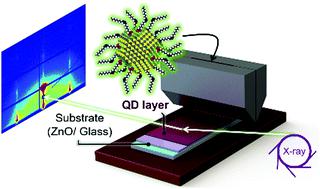当前位置:
X-MOL 学术
›
Nanoscale Horiz.
›
论文详情
Our official English website, www.x-mol.net, welcomes your
feedback! (Note: you will need to create a separate account there.)
Colloidal PbS quantum dot stacking kinetics during deposition via printing.
Nanoscale Horizons ( IF 8.0 ) Pub Date : 2020-03-04 , DOI: 10.1039/d0nh00008f Wei Chen 1 , Haodong Tang , Nian Li , Manuel A Scheel , Yue Xie , Depeng Li , Volker Körstgens , Matthias Schwartzkopf , Stephan V Roth , Kai Wang , Xiao Wei Sun , Peter Müller-Buschbaum
Nanoscale Horizons ( IF 8.0 ) Pub Date : 2020-03-04 , DOI: 10.1039/d0nh00008f Wei Chen 1 , Haodong Tang , Nian Li , Manuel A Scheel , Yue Xie , Depeng Li , Volker Körstgens , Matthias Schwartzkopf , Stephan V Roth , Kai Wang , Xiao Wei Sun , Peter Müller-Buschbaum
Affiliation

|
Colloidal PbS quantum dots (QDs) are attractive for solution-processed thin-film optoelectronic applications. In particular, directly achieving QD thin-films by printing is a very promising method for low-cost and large-scale fabrication. The kinetics of QD particles during the deposition process play an important role in the QD film quality and their respective optoelectronic performance. In this work, the particle self-organization behavior of small-sized QDs with an average diameter of 2.88 ± 0.36 nm is investigated for the first time in situ during printing by grazing-incidence small-angle X-ray scattering (GISAXS). The time-dependent changes in peak intensities suggest that the structure formation and phase transition of QD films happen within 30 seconds. The stacking of QDs is initialized by a templating effect, and a face-centered cubic (FCC) film forms in which a superlattice distortion is also found. A body-centered cubic nested FCC stacking is the final QD assembly layout. The small size of the inorganic QDs and the ligand collapse during the solvent evaporation can well explain this stacking behavior. These results provide important fundamental understanding of structure formation of small-sized QD based films prepared via large-scale deposition with printing with a slot die coater.
中文翻译:

通过印刷沉积过程中的胶体PbS量子点堆积动力学。
胶体PbS量子点(QD)对于溶液处理的薄膜光电应用很有吸引力。特别地,通过印刷直接获得QD薄膜是低成本和大规模制造的非常有前途的方法。QD颗粒在沉积过程中的动力学在QD薄膜质量及其各自的光电性能中起着重要作用。在这项工作中,通过掠入射小角X射线散射(GISAXS),首次在打印过程中就地研究了平均直径为2.88±0.36 nm的小型QD的颗粒自组织行为。峰值强度随时间的变化表明QD薄膜的结构形成和相变在30秒内发生。QD的堆叠通过模板效果进行初始化,并形成了面心立方(FCC)薄膜,其中还发现了超晶格畸变。以身体为中心的立方嵌套FCC堆叠是最终的QD组件布局。无机QD的小尺寸和溶剂蒸发过程中的配体崩溃可以很好地解释这种堆积行为。这些结果提供了通过狭缝模头涂布机进行印刷,通过大规模沉积制备的基于QD的小型薄膜结构形成的重要基础知识。
更新日期:2020-02-27
中文翻译:

通过印刷沉积过程中的胶体PbS量子点堆积动力学。
胶体PbS量子点(QD)对于溶液处理的薄膜光电应用很有吸引力。特别地,通过印刷直接获得QD薄膜是低成本和大规模制造的非常有前途的方法。QD颗粒在沉积过程中的动力学在QD薄膜质量及其各自的光电性能中起着重要作用。在这项工作中,通过掠入射小角X射线散射(GISAXS),首次在打印过程中就地研究了平均直径为2.88±0.36 nm的小型QD的颗粒自组织行为。峰值强度随时间的变化表明QD薄膜的结构形成和相变在30秒内发生。QD的堆叠通过模板效果进行初始化,并形成了面心立方(FCC)薄膜,其中还发现了超晶格畸变。以身体为中心的立方嵌套FCC堆叠是最终的QD组件布局。无机QD的小尺寸和溶剂蒸发过程中的配体崩溃可以很好地解释这种堆积行为。这些结果提供了通过狭缝模头涂布机进行印刷,通过大规模沉积制备的基于QD的小型薄膜结构形成的重要基础知识。









































 京公网安备 11010802027423号
京公网安备 11010802027423号